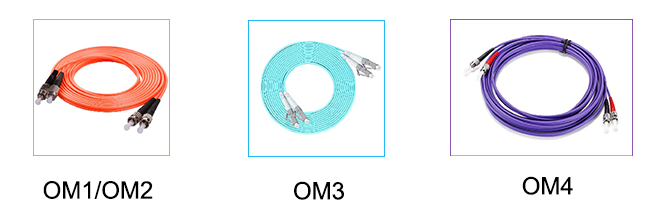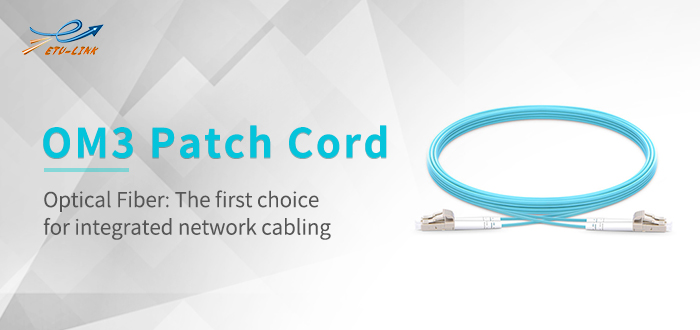Types and selection of multimode optical fiber patch cord
OM
is the abbreviation of optical multi-mode, translated into optical
mode, indicating the grade standard of multimode fiber. Due to the
difference of core diameter, transmission speed and distance, it is
divided into OM1, OM2, OM3 and OM4. This blog ETU-Link will introduce
the difference between them and the method of selection to you.

The difference of OM1, OM2, OM3, OM4 fiber patch cord
1. Different parameters
(1) OM1 refers to 50um or 62.5um core diameter multimode optical fiber with full injection bandwidth of 850/1300nm above 200/500MHz.km;
(2) OM2 refers to 50um or 62.5um core diameter multimode optical fiber with full injection bandwidth of 850/1300nm above 500/500MHz.km;
(3) OM3 is
a 50um core diameter multimode fiber optimized by 850nm laser. In 10Gb /
s Ethernet with 850nm VCSEL, the optical fiber transmission distance
can reach 300m;
(4) OM4 is an upgraded version of multi-mode optical OM3 fiber, and the optical fiber transmission distance can reach 550m.
2. Different uses
OM1 and OM2 have been widely deployed in buildings for many years, supporting the maximum value of 1GB Ethernet transmission;
OM3
and OM4 optical cables are usually used in the data center cabling
environment, supporting 10g or even 40 / 100g high-speed Ethernet
transmission.
3. Different fiber designs
OM1 and OM2 are LED (light emitting diode) as the basic transmission light source, while OM3 and OM4 are suitable for both LED and LD (laser diode) light source transmission.
4. Different transmission speed and bandwidth
The transmission speed and bandwidth of OM optical fiber jumper are increased step by step, OM1
5. Different functions and features
(1) OM1: The core diameter and numerical aperture are large, which have strong light collecting ability and bending resistance;
(2) OM2: The
core diameter and numerical aperture are small, which can effectively
reduce the mode dispersion of multimode fiber, significantly increase
the bandwidth and reduce the production cost by 1/3;
(3) OM3: The
flame retardant sheath can prevent the spread of flame, smoke, acid gas
and toxic gas, and meet the requirement of 10 GB / s transmission rate
(4) OM4: Developed for VSCEL laser transmission, its effective bandwidth is more than twice that of OM3.
After we understand the differences of different multi-mode fiber patch cord, following ETU-Link will give you some small guidelines for choosing patch cords.
1. Select the correct connector. The
connector of optical fiber patch cord has LC / SC / ST / FC / MPO /
MTP. If both ends of the equipment have the same interface, we can use
LC-LC / SC-SC / MPO-MPO. If the interfaces at both ends of the equipment
are different, we can adopt the connection mode of LC-SC/LC-ST/LC-FC.

2. Choose single mode or multimode. Single
mode is mainly used for long-distance transmission and multi-mode is
mainly used for short-distance transmission. In general, the color of
single-mode patch cord is yellow, and that of multi-mode patch cord is
orange, aqua and purple.
3. Choose simplex or duplex. Simplex
patch cord has only one fiber, which is connected by bi-directional
(bidi) optical module. Duplex fiber is two patch cord side by side and
connected with common optical module.
4. Select the length of patch cord. The
length of optical fiber patch cord is generally 0.5m ~ 50m, which is
mainly determined by the distance between equipment and equipment.
The
above is what you need to pay attention to when choosing optical fiber
patch cord. If you want to inquire about purchasing optical fiber patch
cord, welcome to visit our website: www.etulinktechnology.com.
评论
发表评论